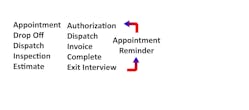Every step of the service process requires some form of communication. Be it between the customer and the advisor, advisor and technician, the advisor and parts store. If any step in the process is not communicated clearly, that step will fail, possibly leading to lost time and an upset customer among other things.
Each step in the service process is a link in a chain. And the chain is only is only as strong as the weakest link. Breaking down the service process steps can look like this.
From beginning to end, each step requires communication for the process to move smoothly. Even though we could explore the in the shop communications and see what can be done to ensure that they happen, this article is mostly going to deal with communications between the shop and its customers.
For decades, the phone has been our main tool for communicating with our customers that leave their vehicles with us. But now the phone has become a hinderance to us getting jobs in and out quickly. Additionally, the way many people communicate is not by the phone but by text.
Many homes had one phone for years and when that phone rang, people made a beeline to answer it before the caller hung up. If you didn’t, you’d have to wait for them to call back leaving you wondering who called in the meantime.
Then the answering machine came along. Now when the phone rang you had to get to it before the answering machine picked up or you’d have to wait for the outgoing message to complete before you could talk.
Soon enough people learned that they could screen their calls by letting the answering machine pick up and hearing who was leaving a message for you. If you didn’t want to talk to the caller, you just let them leave a message. If you wanted to talk, you’d just pick up the phone to stop the recording.
Caller ID and voicemail came along and the demise of the telephone use began. Now people had even more ways of avoiding the phone call if they wished. The Millennials discovered texting and that replaced talking on the phone for their generation.
Phone spam and spoof calls have further reduced people’s use of the telephone. The FCC even put out a statistic stating the more the half of the calls on mobile devices would be spam or spoof during 2019. I can personally attest to this saying that 9 out of 10 phone calls I get on my phone are spoof or spam.
Many people now do what I do. If the phone rings and I don’t recognize the phone number, I let it go to voicemail thinking that if it is an important the caller will leave me a message. Most of the time no message is left. On the few occasions a message is left, I have been told that there are warrants for my arrest in certain states, I owe back taxes or it’s a person leaving an impassioned message in a language I don’t understand. Is it any wonder you cannot reach people via phone anymore?
According to Slicktext.com over 292 million people use text regularly. That represents about 80 percent of the US population. Billions of text messages are sent every day. Additionally, Slicktext.com states that text messages are looked at 90 percent of the time and that 85 percent of customers prefer getting text messages over a phone call or even email. For many, texting is the way they want to communicate with each other and the businesses they deal with.
Some think that texting is only preferred by the Millennials and Gen X generations. The PEW RESEARCH CENTER did a survey in early 2019 that shows not only are the Baby Boomers getting into text, it even shows the Silent generation is starting to adopt the technology. By the way, the Silent generation are those born 1945 and earlier!
So, the question is, “What drives your business?” The answer, of course, is your customers drive your business. I therefore suggest that you communicate with them how they want you to, via text.
I recommend that you have a conversation with your customers about using text as the means of communicating during their appointments and visits with your shop. You need to prepare them for it since they may not expect this from your shop. During this conversation ask the customer if they would be OK with using text. There will be some that don’t like the idea of texting, they rather talk on the phone. That is fine because if you get more than half of your customers to text you, you will free up enough time to talk to those that don’t text.
When having this conversation about texting with a customer, I recommend that you send them a text during it. When they get the text, have them put your shop information into their contacts so whenever they get a text from your shop, they will know it’s about their vehicle. Some texting solutions will send a Vcard, which is a digital business card, on the first text to any phone number making it easier to get your shop info in the customer’s contacts on their phone.
There are a few different ways for a shop to go about using text with their customers. Some shops use a personal phone for texting. This is not such a good idea since you can be texted 24/7. Other shops have purchased a phone to be specifically used for only texting customers. Shops that use this method may have a different individual take the text phone home at night to reply to text messages that may come in.
Text solutions are available that when installed on a PC, allow for sending and receiving text messages from the desktop. Text software can record every conversation with a time stamp keeping a history of communications between the shop and customer. This software can receive text messages 24/7 even when you are closed, at the same time it sends out a response text telling the customer that the text was received, and the shop will reach out to them when open again.
Automatic appointment reminders can be sent out a week before a customer’s vehicle is due for the next service. If the customer confirms the appointment, the shop can preorder any parts that are needed for the visit saving time and money.
You can send a text to the customer when they drop off their vehicle. Throughout the day they can tap on a link and keep up to date on what status it is in. During customer pick up of the vehicle, you can send a text message to the happy customer so they can review you on Google or Facebook with just a few taps of their finger on their phone.
Texting isn’t only for texting anymore. Text can be used to send digital inspections that have clear descriptions, pictures and video that can be viewed right on the customer’s phone. Documents such as estimates, and invoices can be sent via a text message. Saving paper and getting customer responses quicker.
Customers can even pay for their services using text. Collect that money sooner than later. Customers pay and pick up the vehicle after hours. Everything is encrypted, signature stored, and authorization time stamped on the digital invoice. They even get a copy of the paid invoice with the word PAID stamped on it sent to their phone.
You know the frustration of not being able tell a calling customer whether the vehicle is safe to drive to the shop when a warning light illuminates on the dash. Instead of them telling you the light looks like a Tie Fighter from Star Wars. You have the customer take a picture and text it to you so you can identify it correctly and answer the question safely.
It is my hope that at this point if your shop isn’t currently using text to communicate with today’s customers the way they want you to. That you will change your mind and embrace text. Get a text solution, have a conversation with your customers about text and their vehicle, and get off that phone. I can almost assure you that your shop will benefit by seeing less wasted time waiting for that phone to ring.


